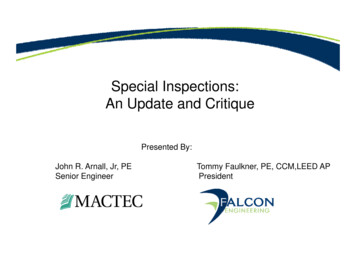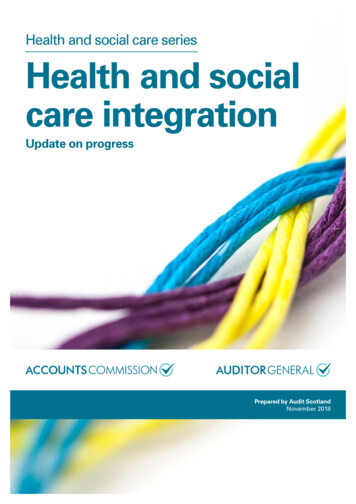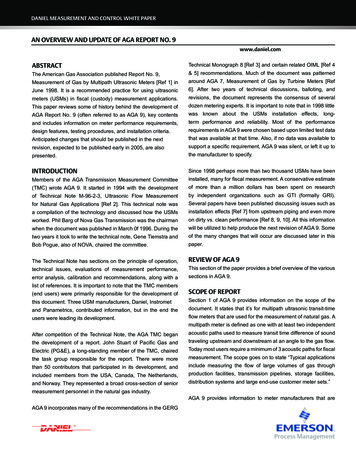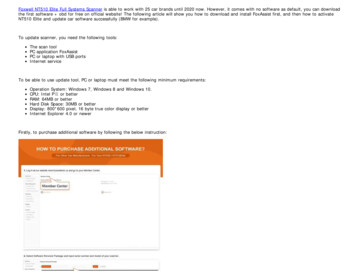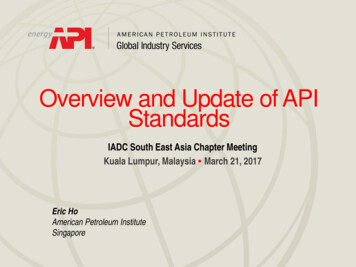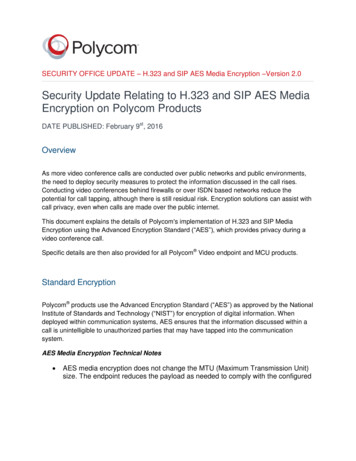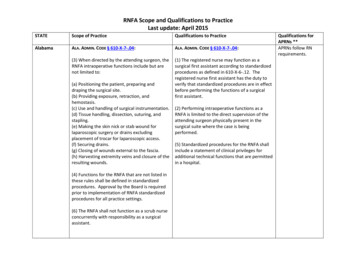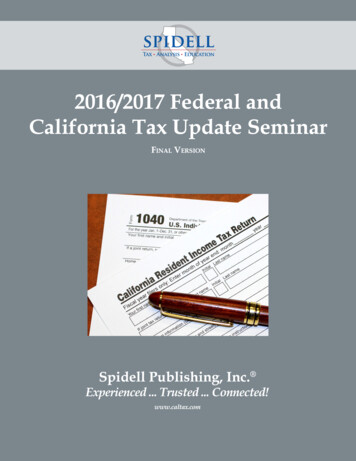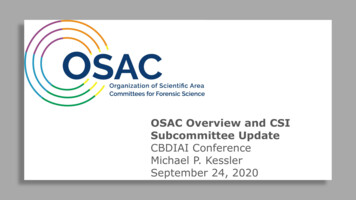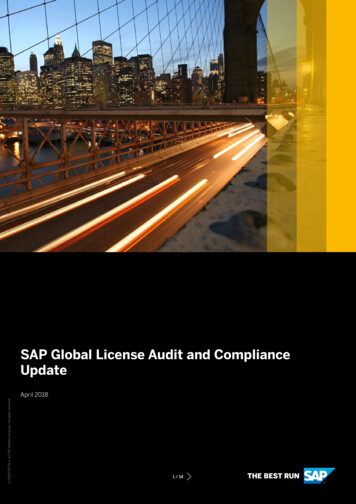
Transcription
Portfolio Media. Inc. 111 West 19th Street, 5th Floor New York, NY 10011 www.law360.comPhone: 1 646 783 7100 Fax: 1 646 783 7161 customerservice@law360.comAn Update On DTSA And Trade Secret DamagesBy Daniel McGavock, Robert Goldman and Jack Roberts(June 26, 2018, 12:18 PM EDT)The Defend Trade Secrets Act became law two years ago, bringing a new federal cause ofaction for companies seeking to protect their trade secrets. Since then, there have beenmore than 800 DTSA cases filed in federal district courts. News of cybersecurity breaches, amore mobile workforce and improved visibility associated with DTSA cases in federal courtshighlight the importance and value of trade secrets. In this article, we provide a briefupdate on DTSA cases and discuss two recent cases trade secrets litigators need to beaware of relating to damages.Two-Year DTSA Filing OverviewIn total, there have been 828 new cases filed with DTSA claims in the two years since theDTSA became law.[1] Figure 1 shows the monthly filing history of DTSA claims, with asignificant uptick in monthly DTSA filings occurring in 2017 and continuing in 2018.Daniel McGavockRobert GoldmanFigure 1- Monthly DTSA Filings[2]Jack Roberts
DTSA claims have been filed in 77 of the 94 federal district courts in the U.S. (approximately 82 percent),with the Northern District of Illinois (ILND), Northern District of California (CAND), Central District ofCalifornia (CACD), Southern District of New York (NYSD) and Eastern District of Pennsylvania (PAED)being the most popular districts to date, as shown in Figure 2. This comports well with historic venuesfor trade secret cases heard in federal courts under state or common law, as indicated in a study oftrade secret cases heard in federal courts from 1950 to 2008. In that study, five of the top districts were:the Northern District of Illinois, Southern District of New York, Eastern District of Pennsylvania, Districtof Minnesota and Northern District (MND) of California.[3]Figure 2 – Federal District DTSA Filing Activity (May 11, 2016 – May 10, 2018)[4]Of the 828 DTSA cases filed, 400 (48 percent) have already terminated, with 225 of those (56 percent)terminating within six months, as shown in Figure 3. In terms of tracking damages outcomes under theDTSA, there have been few DTSA cases in which a damages verdict was reached in district court, andsome of those have remaining questions of law. For example, in Dalmatia v. FoodMatch, the case withthe “first DTSA damages award,” there was a post-trial dispute over whether the 500,000 jury awardfor trade secret damages was for the DTSA or Pennsylvania Uniform Trade Secrets Act claim.[5] Thus, itis too early in the life of the DTSA to begin to understand if, and how, damages trends may be impacted.
Figure 3 – Length of Terminated DTSA Cases[6]Trade Secret Damages — Recent Case Law DevelopmentsDamages remedies available under the DTSA are similar to those under the Uniform Trade Secrets Act,or UTSA. According to the DTSA, economic remedies include: (1) damages for actual loss caused by themisappropriation of the trade secret; and (2) damages for any unjust enrichment caused by themisappropriation of the trade secret that is not addressed in computing damages for actual loss; or (3)in lieu of damages measured by any other methods, the damages caused by the misappropriationmeasured by imposition of liability for a reasonable royalty for the misappropriator’s unauthorizeddisclosure or use of the trade secret.[7]The DTSA provides another layer of federal protection over the existing patchwork of state laws butdoes not preempt state law. As such, a trade secret owner may bring a claim under the DTSA, existingstate law or both. Therefore, it is important to monitor and understand both DTSA and state law casedevelopments in developing case filing and management strategies. The remainder of this article willfocus on two very recent and notable appellate decisions on the subject of trade secret damages.Disgorgement of Defendant’s Profits: TAOS v. IntersilTexas Advanced Optoelectronic Solutions Inc., or TAOS, and Renesas Electronics America Inc., f/k/aIntersil Corporation both develop and sell ambient light sensors used in electronic devices to adjustscreen brightness in response to incident light. The parties shared confidential technical and financialinformation during negotiations for a potential merger which never materialized. In November 2008,TAOS sued Intersil in the Eastern District of Texas for trade secret misappropriation (under Texas law),and other matters.[8] For the trade secret misappropriation claims, the jury in the April 2015 trialawarded TAOS 48.8 million in disgorgement of Intersil’s profits.
On appeal to the Federal Circuit, Intersil argued, among other arguments, that the district court erred inrelying on the jury’s verdict on disgorgement damages for the trade secret misappropriation claim, sincethis was an equitable issue for the court to decide, not the jury. The parties disputed whether TAOS hasa Seventh Amendment right to a jury decision on its request for disgorgement of Intersil’s profits. “TheSeventh Amendment, ratified in 1791, provides that, ‘[i]n suits at common law, where the value incontroversy shall exceed twenty dollars, the right of a trial by jury shall be preserved.’”[9] The FederalCircuit’s decision rested on answering the following question: “Did the law courts award the defendant’sprofits as a remedy for this kind of wrong [in 1791]?”Ultimately, the Federal Circuit determined that while in some cases disgorgement of the defendant’sprofits could be considered a “proxy” measure of damage to the plaintiff, such was not the case here. Assuch, disgorgement in this case was a matter of equity to be determined by the court, not a matter oflaw to be determined by a jury (“From all we have seen, no disgorgement remedy was available at law in1791 for the former claims. We conclude that no such remedy would have been available at law for thetrade secret misappropriation here, either.”[10]) The case was remanded on other grounds, but theFederal Circuit provided this opinion to be considered on remand.A key takeaway is that parties should consider how to present their damages case for trade secretmisappropriation cases where damages are based on a disgorgement of the defendant’s profits. Unlessthe defendant’s profits are a proxy for the plaintiff’s actual damages, this case suggests the amount ofdisgorgement is properly determined by the court, not the jury.Avoided Cost Theory: E.J. Brooks (d/b/a TydenBrooks) v. Cambridge Security SealsThe TydenBrooks trade secret misappropriation case filed in New York is important as it followscommon law (versus a form of the UTSA). As presented above, New York is one of the top states forfiling trade secret misappropriation suits.TydenBrooks and Cambridge Security Seals, or CSS, manufacture plastic security seals. In 2012,TydenBrooks filed a federal suit in the Southern District of New York against CSS, asserting common lawmisappropriation of trade secrets, unfair competition and unjust enrichment.[11]TydenBrooks measured its injury by CSS’ avoided costs (a “type of disgorgement”) as a result of themisappropriation — it did not provide any evidence of its own losses or argue that the avoided costs ofCSS were a proxy for its own losses. The damages expert for TydenBrooks estimated that CSS avoided aminimum of 6.1 to 12.2 million in development costs.The court charged the jury only on the avoided cost theory. The jury found CSS liable, and assessed 1.3million against CSS for the misappropriation claim. The trial court denied the CSS post-trial motion thatavoided costs was an improper measure of damages.On appeal, the Second Circuit noted that neither New York courts nor the Second Circuit have approvedthe specific type of damages (defendant’s avoided costs). The Second Circuit certified the question tothe New York Court of Appeals as to whether, under New York law, a plaintiff asserting misappropriationof a trade secret can recover damages measured by the avoided costs of the defendant.In a 4-3 split decision, the New York Court of Appeals determined that under New York common law,“compensatory damages must return the plaintiff, as nearly as possible, to the position it would have
been in had the wrongdoing not occurred — but do no more. Accordingly we answer this question in thenegative.”[12] The court indicated that courts may award a defendant’s unjust gains to the extent thoseprofits are evidence of the plaintiff’s own losses, but that was not the case here. The court alsoacknowledged that there are other damages regimes that permit recovery of unjust gains (presumably,UTSA and DTSA regimes), but not under New York common law.The dissenting opinion is sharply critical of the majority’s opinion, stating that “[t]he approach providedby nearly all other jurisdictions and the restatement (third) of unfair competition explicitly allowsplaintiffs in trade secret cases to recover the plaintiff’s cost of development or the defendant’s avoidedcosts. That is of no moment to the majority. The suggestion that our court — the court that, in Judge[Benjamin] Cardoza’s time and thereafter, led the nation in advancing the laws that govern civil wrongsin contract, tort and equity — should turn a blind eye and disregard our duty is most perplexing.”[13]A key takeaway from this case is that plaintiffs filing trade secret misappropriation claims in New Yorkmust carefully consider the now important differences in the types of recoverable damages betweenNew York common law and the DTSA since a defendant’s avoided costs cannot be claimed as damagesunder New York common law.ConclusionWith very few DTSA cases having returned damages verdicts, there is not much evidence to point to theact's overall impact on damages. Will DTSA cases begin to follow a more consistent procedural processand damages case law framework similar to patent cases? For example, given the impact of trade secretdefinition on both liability and damages, will a standard procedural process to define the trade secretsearly in a litigation emerge (similar to claim construction hearing in a patent case)? Will courts have anenhanced gatekeeper role regarding damages experts as it did in the Waymo v. Uber case? Will there bean increased focus on apportionment for trade secret cases similar to the trend in patent cases?The answers to these questions should become more evident as more cases filed under the DTSAproceed to trial and return damages verdicts. Whether a trade secret misappropriation case is assertedunder state law, common law or the DTSA, it is important to remember that evaluation of trade secretdamages is highly case- and fact-specific, and should be aligned with sound economic and valuationprinciples.Daniel M. McGavock, vice president and intellectual property practice leader, Robert B. Goldman, vicepresident, and Jack Roberts, associate, are damages and valuation consultants at Charles RiverAssociates.The opinions expressed are those of the author(s) and do not necessarily reflect the views of the firm, itsclients, or Portfolio Media Inc., or any of its or their respective affiliates. This article is for generalinformation purposes and is not intended to be and should not be taken as legal advice.[1] Docket Navigator search conducted on May 22, 2018, and includes cases filed between May 11, 2016and May 10, 2018 with DTSA claims or counterclaims.[2] CRA analysis, based on Docket Navigator search conducted on May 22, 2018, and includes cases filedbetween May 11, 2016 and April 30, 2018.
[3] David S. Almeling, et al., “A Statistical Analysis of Trade Secret Litigation in Federal Courts,” GonzagaLaw Review 45, no. 2 (2010) at 310.[4] CRA analysis, based on Docket Navigator search conducted on May 22, 2018, and includes cases filedbetween May 11, 2016 and May 10, 2018.[5] Law 360: “Corrected: Food Cos. Dispute Trade Secrets Verdict in Fake Jam Suit,” April 5, 2017.[6] CRA analysis, based on Docket Navigator search conducted on May 22, 2018, and includesterminated cases filed between May 11, 2016 and May 10, 2018.[7] Defend Trade Secrets Act of 2016, §2(b)(3)(B).[8] Texas Advanced Optoelectronic Solutions Inc., v. Renesas Electronics America Inc., f/k/a IntersilCorporation, Fed. Cir., 2016-2235, May 1, 2018.[9] Ibid, pp. 23-24.[10] Ibid, p. 35.[11] E.J. Brooks Company v. Cambridge Security Seals, State of New York Court of Appeals, No. 26, May8, 2018.[12] Ibid, p. 2.[13] Ibid, p. 25.
[3] David S. Almeling, et al., A Statistical Analysis of Trade Secret Litigation in Federal ourts, _ Gonzaga Law Review 45, no. 2 (2010) at 310. [4] CRA analysis, based on Docket Navigator search conducted on May 22, 2018, and in

